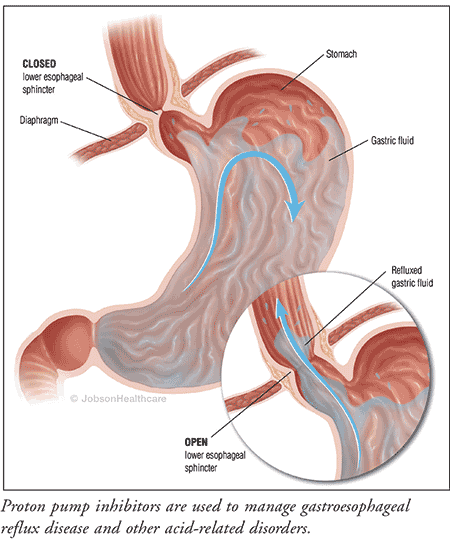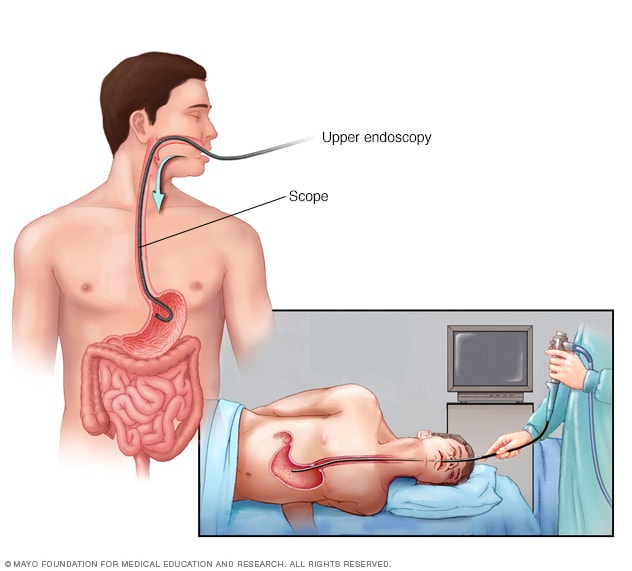
Severe inflammation can give rise to erosions and ulcerations. Basal cell hyperplasia and intraepithelial eosinophils are the characteristic microscopic features. The squamous epithelium of the esophagus is inflamed as a result of the repeated exposure to the gastric acids. Reflux Related Changes in the Squamous Epithelium In the case of an atypical presentation, it is necessary to exclude other possible causes such as ischemic heart diseases. The function of the lower esophageal sphincter is assessed by manometry. The measurements are taken over a period of 24 hours. The reflux of the acid into the lower esophagus is measured objectively by placing a pH probe at the lower end of the esophagus. In some occasions, it is possible to have asymptomatic GERD where the patient does not have any symptoms in spite of the ongoing damage to the esophageal mucosa. Atypical symptoms – abdominal pain, chest pain, chronic cough, hoarseness, asthma, post nasal drip.Typical symptoms – heart burn, regurgitation.

This increases the risk of esophageal adenocarcinomas. Repeated exposure to gastric acids damages the esophageal mucosa and the damaged cells are replaced by regeneration. GERD has been recognized as a lifestyle related disease that is commonly seen among people who have adopted a “Western type” life style. Although the reflux of acidic gastric content is a common phenomenon which occurs in almost everyone, the weakening of the gastro esophageal sphincter increases the amount of gastric reflux to a significant level that ultimately results in GERD. If you experience significant or new abdominal pain or unexplained weight loss or appetite changes have dark (tar-like) stools or trouble breathing or feel faint or are vomiting blood, seek immediate medical care.Gastro esophageal reflux disease (GERD) is due to the reflux of the gastric content into the lower esophagus. When left untreated, peptic ulcers can cause internal bleeding, perforation of the stomach or small intestine, infection of the abdominal cavity, or an obstruction in the GI tract. While acid reflux and peptic ulcer disease may share some similar symptoms and treatments it is vital to get an accurate diagnosis**. Should the cause of your peptic ulcer be linked to NSAIDs, your doctor will usually recommend discontinuing the medication (or recommend an alternative pain reliever) along with acid suppressing medications. Pylori infection is confirmed (usually by a simple blood or breath test) your doctor will most likely prescribe a combination of two antibiotics along with acid suppressing medications.

Peptic ulcer treatment may vary depending on the cause contributing to the problem. As with acid reflux disease, people who smoke, drink alcohol in excess, or eat spicy foods may be more likely to develop peptic ulcers. These medications, while great for reducing inflammation in conditions like arthritis or pulled muscles, can irritate the lining of the GI tract.

Another factor that can contribute to the development of peptic ulcer disease is the overuse of NSAIDs. In most cases it doesn’t cause any problems, but for some it can cause irritation and ulcers. Pylori can be found in the mucosal layer of the GI tract. Peptic ulcer disease is most frequently caused by a bacterial infection or the overuse of certain medications. So it is easy to see why the initial symptoms of peptic ulcer might be confused with acid reflux disease.
#THE DIFFERENCE BETWEEN ACID RELUX AND AN ULCER FULL#
Some of the symptoms of peptic ulcer disease include burning stomach pain, feeling full quickly, bloating, intolerance to fatty foods, heartburn, and nausea.

Peptic ulcers occur when the acid in the digestive tract eats away at the lining of the stomach or small intestine, creating irritated or raw spots that can become painful open, bleeding sores.


 0 kommentar(er)
0 kommentar(er)
